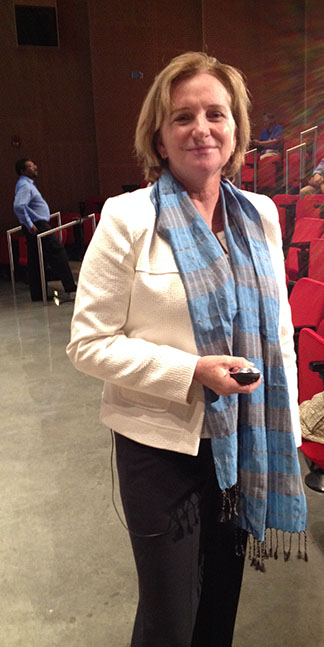Cathy Casserly, who works with open learning opportunities and knowledge sharing at the Hewlett Foundation, delivered the afternoon keynote at the LWMOOC conference at MIT today.
Casserly is a consultant to the William and Flora Hewlett Foundation, an innovative space where individuals are encouraged to take risks in an environment where attention is paid to the system level and the collective eco-system. Casserly was also former CEO of Creative Commons and VP of Carnegie Foundation for Advancement of Teaching.
 Tracing historical highlights of the MOOC movement, Casserly outlined how the Hewlett Foundation funded the original Open Courseware initiative at MIT - the first of it’s kind in the world. Initially created so that “people could peer into MIT through an open window”, OCW was also – and just as importantly – established to improve teaching and learning She noted a general geographic trend of thirst from the south for materials from the north. However, in keeping with the permeability and fluidity of boundaries in an age of sharing, she also noted a trend for recipients to share and contribute, resulting in a collaborative and reciprocal learning environment.
Tracing historical highlights of the MOOC movement, Casserly outlined how the Hewlett Foundation funded the original Open Courseware initiative at MIT - the first of it’s kind in the world. Initially created so that “people could peer into MIT through an open window”, OCW was also – and just as importantly – established to improve teaching and learning She noted a general geographic trend of thirst from the south for materials from the north. However, in keeping with the permeability and fluidity of boundaries in an age of sharing, she also noted a trend for recipients to share and contribute, resulting in a collaborative and reciprocal learning environment.
The fundamental goals of MOOCs were to level the playing field for all learners, giving everyone access to course content and materials. The ensuing challenge was to ensure that MOOCs were easy to use, and provided material that was stimulating to interact with.
One of the most important components of the MOOCs is open licensing, also a critical part of OERs. Prior to 2002 there were two publishing modalities: copyright-protected or public domain – two extremes. Everything was copyrightable: a squiggle, a textbook, a design, etc. One did not even need the copyright © stamp: copyright was the default.
But the rise of the Internet created space for sharing, re-mixing, and multiple copies. The challenge was for the law to keep up. In addition it was not easy for creators and sharers to communicate specific desires in regards to fair use and how to share content with the world. In response to this confusion, Creative Commons devised a 4-part array of permissions starting with creator attribution (1), proceeding to full sharing permissions with attribution (2), extending to backward permissions to share and share alike (3), and concluding with (4) disallowing the use of derivative material.
Casserly outlined the two major strains of MOOCS:
She also explored the differences and similarities between MOOCs and OERs. Although both are free, only OERS give permissions to re-use, revise, re-mix and re-distribute. Few MOOCs do. In addition, OERs are created for the public good without a profit model whereas many MOOCs seek revenue.
In regards to copyright, universities and faculty are the copyright holders of MOOC content. This presents a challenge to MOOCs – to provide a range of functionality with respect to copyright and thus allow copyright holders to add creative commons licensing.
One of the most interesting MOOCs is Open Up Ed – a pan-European initiative, founded by the European commission, just underway. Open Up Ed utilizes all aspects of principal of openness – open platform, open licensing of content, sharing data. Because of this, Open Up Ed typifies the ‘holy grail’ for MOOCs with open data, open content and open platform.
With more sophisticated platforms is now possible to collect data at scale. But questions arise as to who owns the data, who will have access to the data, and how is data shared? Further questions arise around issues of privacy.
Collectively scholars need to examine their instincts around creativity and the prevailing attitude that, “if I create it myself, it will be better”. There is no empirical evidence to support this, but the mis-conception persists, and there is a bit of the ego involved.
-Molly Ruggles (ruggles@mit.edu)